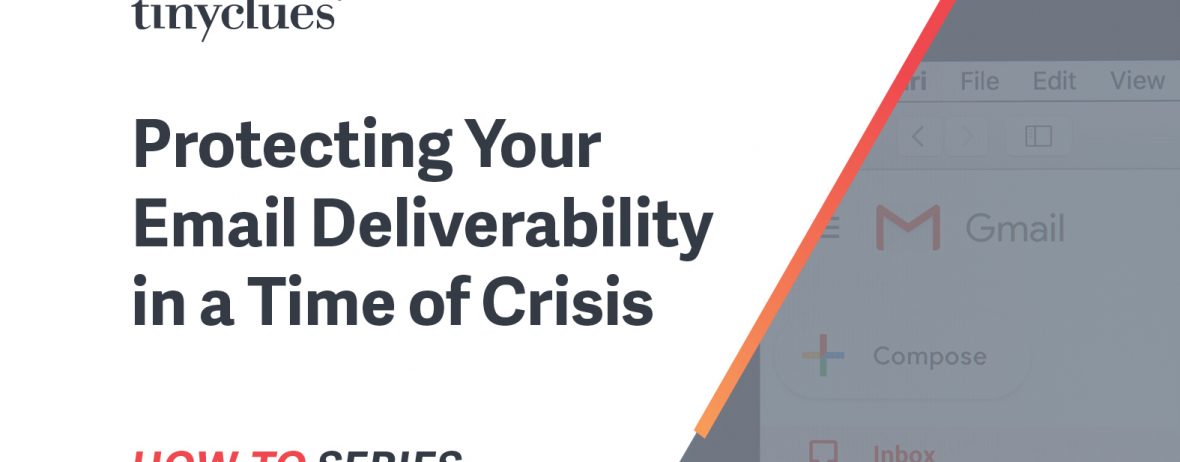Part of Tinyclues’ How-To Series:
A collection of blog posts and webinars to help guide you through your customer analytics and campaign activities, and optimize your customer communications.
During this current health crisis, we’re all concerned about the closest people in our lives. Never far from our minds: our collective health, the logistics of childcare and groceries, balancing working from home and how our jobs and industries will evolve.
When this is finally behind us, most of us will need to reassess our marketing strategy for 2020, find ways to reconnect with our customers and the market, and try to catch up on lost revenue. One concern that several of our customers have expressed is about email deliverability.
How do you protect your deliverability now and after the crisis?
Your email sender reputation takes years to build and is based on many factors, such as engagement, bounce rate, unsubscribes, content and format, IP address and more. Email deliverability is at the center of your marketing efforts, as it is one of the top channels you have to reach your customers and provide them with relevant content. If you’re not reaching your customers’ inboxes – they’re not engaging with your products! As a marketing, CRM, or merchandising professional, you must fight to protect your “sender” reputation, even in unexpected circumstances.
Protecting your deliverability right now
Keeping track of engagement metrics
The most important piece of advice right now is to monitor your engagement metrics (open rate, click-through rate, bounce rate, etc.) and quickly adjust your communications to maintain a good reputation. Remember, sending consistent emails is one of the ways that you are deemed to have a good reputation.
Changing volume progressively
We know it sounds counterintuitive, but if you don’t send out roughly the same volume of emails per week, you may be penalized when your normal schedule returns. However, if you intend on reducing the volume of emails during this crisis – as we suspect that many of you will, given the circumstances, you are well-advised to do this progressively. An abrupt change in volume could affect your sender reputation, as well as your hard bounce rate.
What if you can’t send the same amount of emails during this crisis?
Crises happen, and you may not be able to match the same number of communications as before. To increase good open rates, adapt the subject line and ensure that the message and content are optimized for your audience. With this approach, you can try to convert as many contacts as possible with your limited communications.
Keep track of your metrics and begin to plan for your progressive return to your campaign plan. As you will see below, ease back into your normal schedule little by little, or your sender reputation risks being further harmed.
How can Tinyclues help?
We can adapt our algorithms so that the target audience will be more likely to have high click and open rates. This will allow you to optimize your engagement rates and protect your deliverability rate, even when you have limited communication with your customers. Reach out to your CSM for more information.
Protecting your deliverability after the crisis
Volume is mostly consistent as before
If you are able to keep the same amount of emails during the crisis, your goal will be to keep high engagement rates at a time when every other company will be vying for your customers’ attention. Messages, therefore, must be even more relevant and targeting will be more important than ever. Send the right communication to the right customers to maintain your engagement rates.
Volume is different than before
If maintaining the same schedule you had before is not an option, avoid the temptation to over-solicit your customers and talk about all of your offers at once. First of all, you can’t rely on customers to read your emails and select the product that best answers their needs.
Second of all, as a marketer, you are responsible for providing your customers with the most relevant offer for each of them. A “batch and blast” campaign, several times a week, is a poor solution. Many customers will not react well, which will affect your unsubscribe rate. Plus, many brands can’t risk damaging their brand image by blasting or over-soliciting their customer base – even after an unprecedented event like the current health crisis.
As mentioned above, any abrupt change – whether reducing or increasing volume – will affect your sender reputation. When you begin sending campaigns again, send them progressively, over the course of a few weeks. Make sure to optimize the targeting and follow your company guidelines for fatigue management.
How can Tinyclues help?
Tinyclues allows you to define the best audience for your campaigns. Our algorithm’s objective is to select the customers with the highest probability to purchase the products promoted in your communications. By doing so, we observe improved engagement rates, as your customers receive campaigns that truly interest them. As a marketer, you can also define the maximum number of communications per user, per week, and fully control fatigue management across your entire customer database.
A delivery expert offers his opinion on algorithm changes
Google, Yahoo and many of the top email service providers (ESP) will probably adapt their algorithms in light of current events, especially as businesses around the world are affected. Algorithms are constantly evolving, so some changes may appear in the near future, although it is hard to guess what is adjusted, as their scoring criteria are not published publicly.
With these tips, you can better assess what indicators to watch during this time, and how you can best protect your deliverability score. Remember, this won’t last forever, and you will need to be ready when your marketing plan picks up again. Re-evaluate your plans, messaging and volume now, so that the return will go as smoothly as possible for you and your customers.
We will continue to monitor the ESP market and update this article, as needed, to reflect the changes industry experts see in the coming days and weeks. In the meantime, take care of yourselves and those around you.
Coming soon
Stay tuned for more how-to articles and webinars from Tinyclues. We draw expert information from our international team members – CSMs, data scientists, marketers and more. Community is important – we’re here to help!



